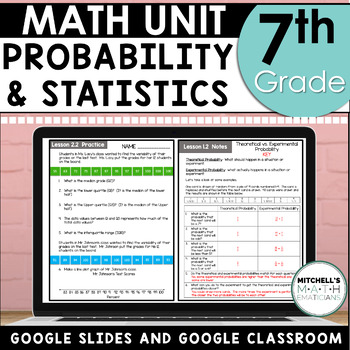7th Grade Probability and Statistics Unit Using Google
- PDF
- Google Apps™

Also included in
- Looking to integrate technology into your 7th grade math curriculum? This common core aligned product engages your seventh grade students through interactive Google slides. You can assign this to your students digitally or print the slides and distribute them to you students in your classroom. ThisPrice $158.00Original Price $192.50Save $34.50
Description
Looking for distance learning math materials? In this 7th grade math NO PREP product you get an entire unit on statistics and probability. This common core aligned product engages your seventh grade students through interactive Google slides. Using Google Classroom makes it easy to assign lessons to your students digitally. Topics included are probability, measures of center, quartiles, mean absolute deviation, histograms, box-and-whisker plots, and stem-and-leaf plots. All you have to do is share the file with your students and they can get started. Text boxes are included so your students know where to type their answers. The Google Slides are sized at 8.5 x 11 so you can print them off as well if you wish.
An overview of the unit and a sample day-by-day lesson plans are included as well. Obviously this can be adjusted based on how much time you have to teach each day.
ALL chapters include:
- Notes
- Practice Pages
- Answer Keys
Chapter 1 – Probability
- Simple Probability
- Theoretical vs. Experimental Probability
- Compound Probability
Chapter 2 – Measures of Center
- Mean, Median, Mode, and Range
- Quartiles and Inner Quartile Range
- Mean Absolute Deviation (MAD)
Chapter 3 – Displaying Data
- Histograms
- Box-and-Whisker Plots
- Stem-and-Leaf Plots
There is also an assessment (quiz) over each chapter and a test over the entire Unit! There is a review for each of the quizzes as well. If you assign the Google Form Quiz it is self grading! There is one for each chapter and a Google Form self grading test over the entire unit.
*This is the same product as 7th Grade Statistics and Probability Unit 7 except this is on Google!






